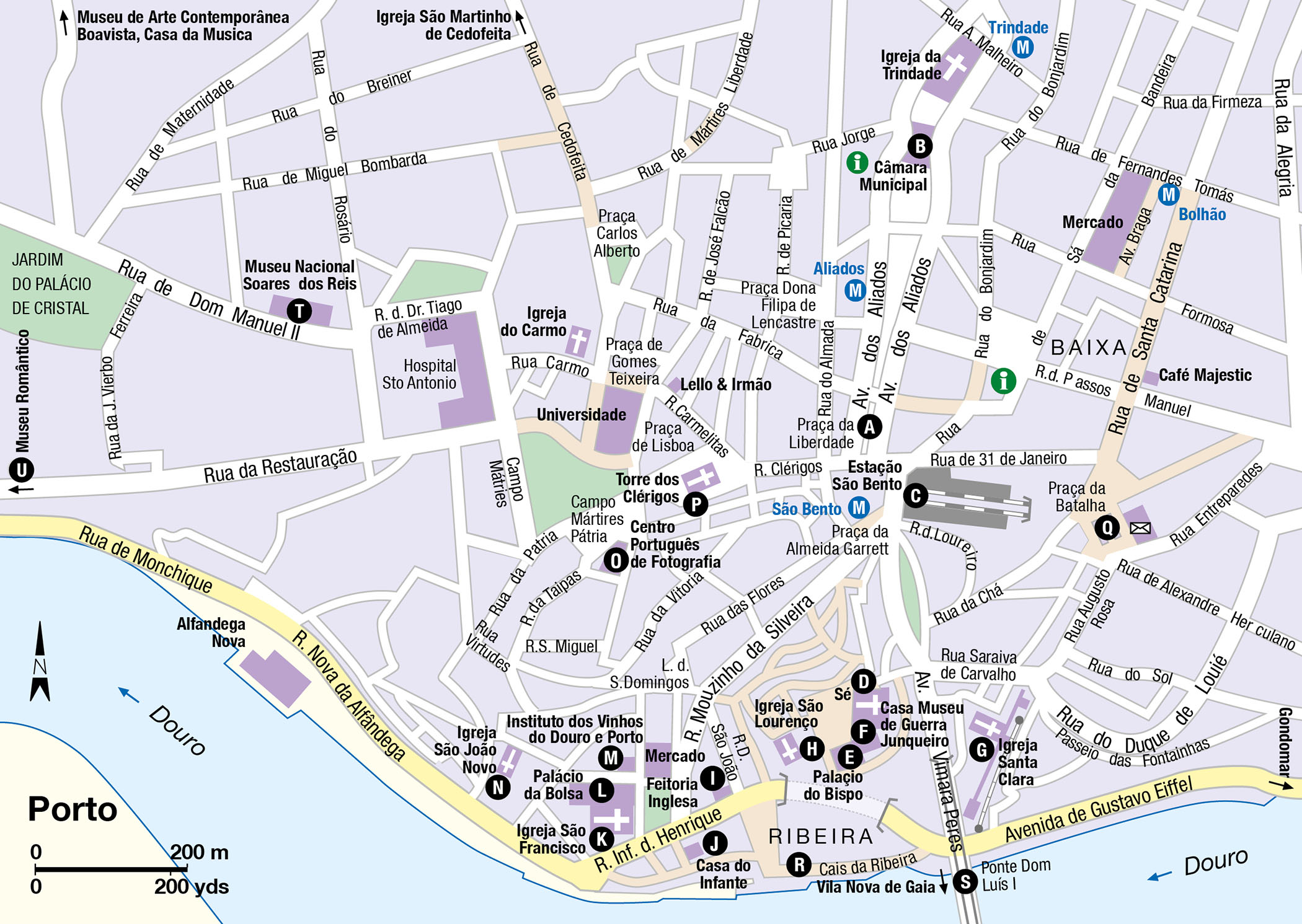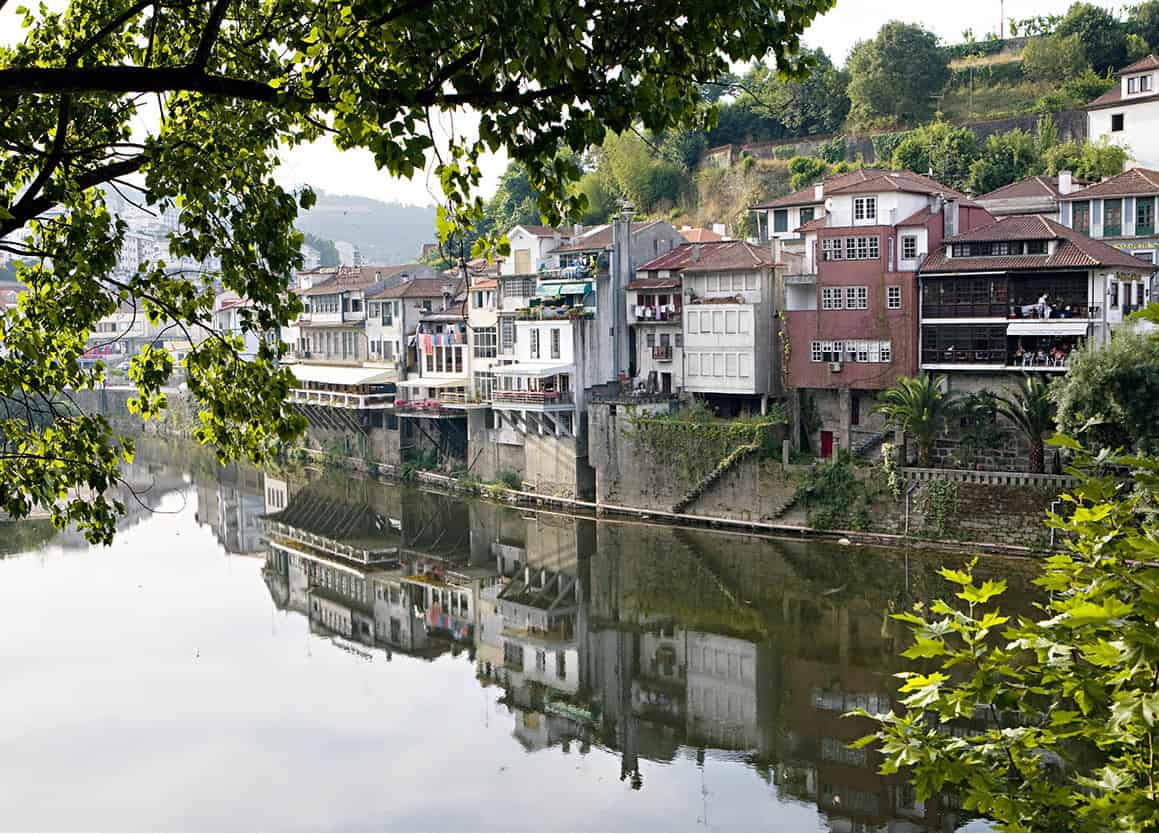Porto 1 [map] is the commercial centre of northern Portugal, a fascinating city with a long and colourful history that is reflected in the culture, lifestyle and architecture. Its historic centre is a Unesco World Heritage Site. In many ways, Porto is a northern European city, with granite church towers, stolid dark buildings, and hidden Baroque treasures. But there is a real southern European feel here, as well, particularly around the Ribeira bairro where the narrow backstreets, hung with washing, and dusty old-fashioned shops have a hint of Naples about them.
Posed majestically on the rocky cliffs overlooking the Rio Douro, Porto is linked by six bridges to Vila Nova de Gaia, where most of the port-wine lodges are located, fronted by their moored barcos rabelos (for more information, click here). These days, large ships dock at the seaport of Leixões, but coal barges, fishing trawlers and other small vessels still sail up the river, and a river trip is a great way to see the city. The climate in town is temperate, and the Portuenses, as the inhabitants are called, are traditionally industrious – as reflected in the well-known Portuguese saying: “Coimbra studies, Braga prays, Lisbon shows off and Porto works.”
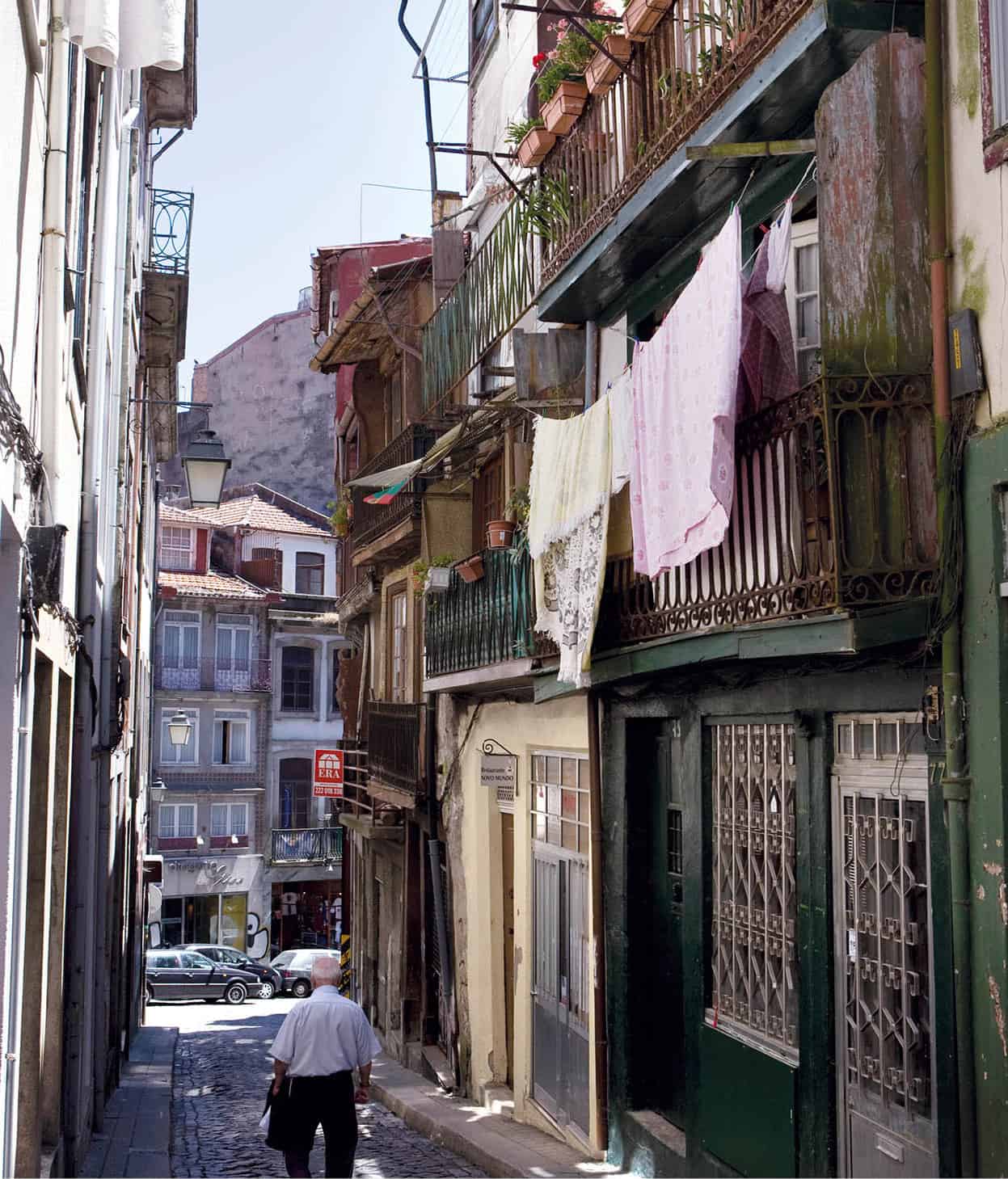
A cobbled street in Porto.
Lydia Evans/Apa Publications
In Roman times, the twin cities at the mouth of the Douro were known as Portus on the right bank and Cale on the left. During the Moorish occupation, the entire region between the Minho and Douro rivers was called Portucale. When Afonso Henriques founded the new kingdom in 1143, he took the name of his home province and called it Portucalia.
Porto prospered from the seafaring exploits of the golden epoch of discoveries. Its shipyards, adapting Douro river caravelas, produced caravels that sailed around the world. Prince Henry, who initiated and inspired exploration, was born here.
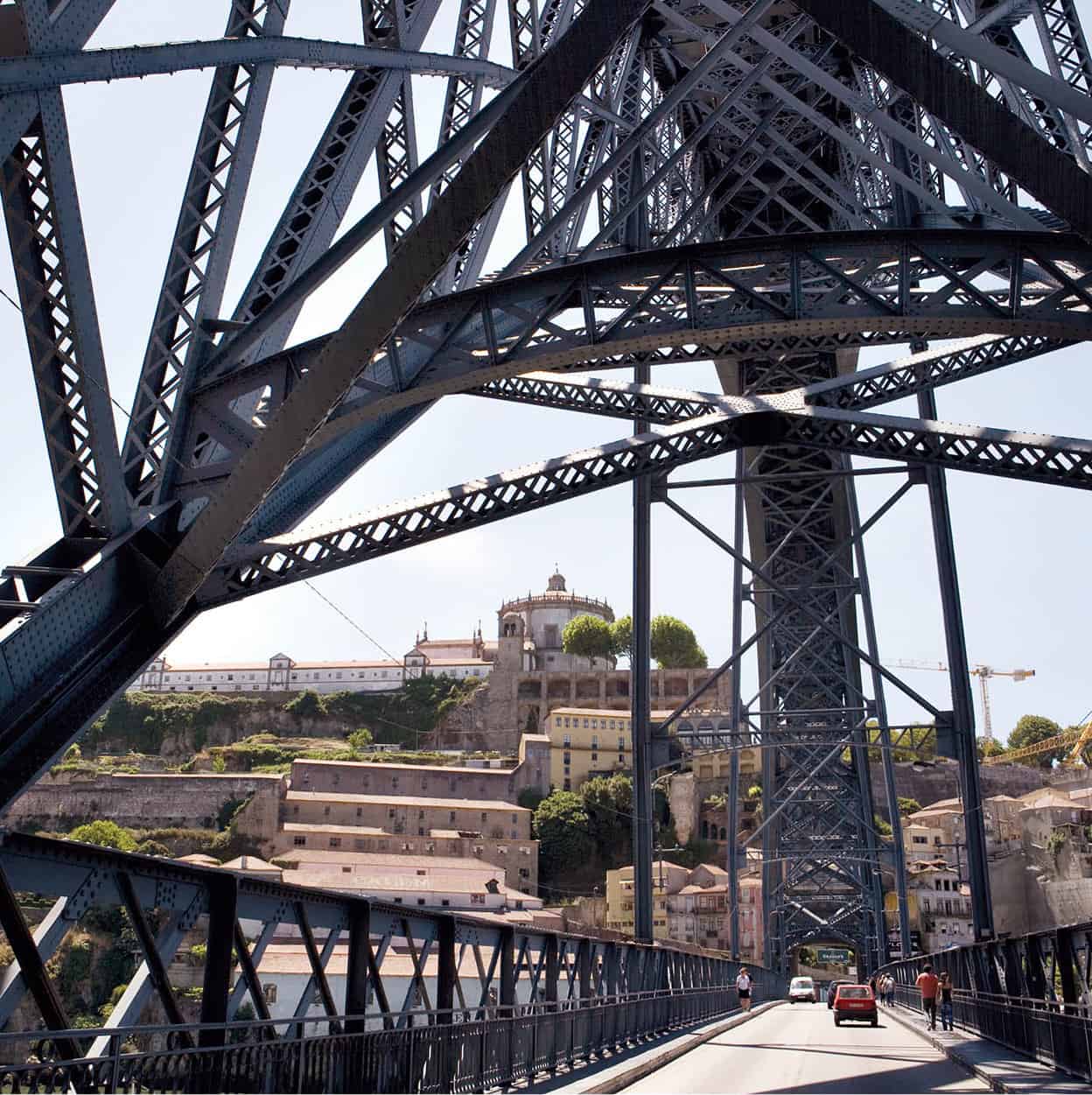
Driving over Dom Luís Bridge.
Lydia Evans/Apa Publications
The wine trade
In the 17th and 18th centuries, the wines of the Upper Douro were robust table reds. Then, in 1820, a “climatic accident” occurred, with warm weather producing unusually sweet grapes, with a resulting sweet tipple, particularly appreciated by the British. In the following years, the wine companies added aguardente, or brandy, to stop the fermentation and fix the sugar content. This was the beginning of the sweet fortified wine so famed today. England’s long connection with the city they called Oporto had been developing with the wine trade (for more information, click here). The Methuen Treaty of 1703 opened English markets to Portuguese wines, and the English shippers of Porto became increasingly rich and powerful. In 1727 they established a Shippers’ Association, which regulated the trade and controlled prices paid to Portuguese growers. Thirty years later, to combat the English monopoly, the Marquês de Pombal founded the Alto Douro Wine Company. Today the business is organised and controlled by the city-based Port and Duoro Wines Institute.
Porto is an energetic and lively commercial city with an individual taste in food and drink. Regional specialities include roast pork, fresh salmon, lamprey, trout and tripe. The most popular bars and restaurants (justifiably so) are by the river around Cais de Ribeira and in Vila Nova de Gaia opposite. You may hear fado in a few restaurants, such as Mal Cozinhado at Rua Outerinho 13, while those seeking a more vigorous nightlife head for Foz de Duoro 4km (2 miles) downstream by the sea.
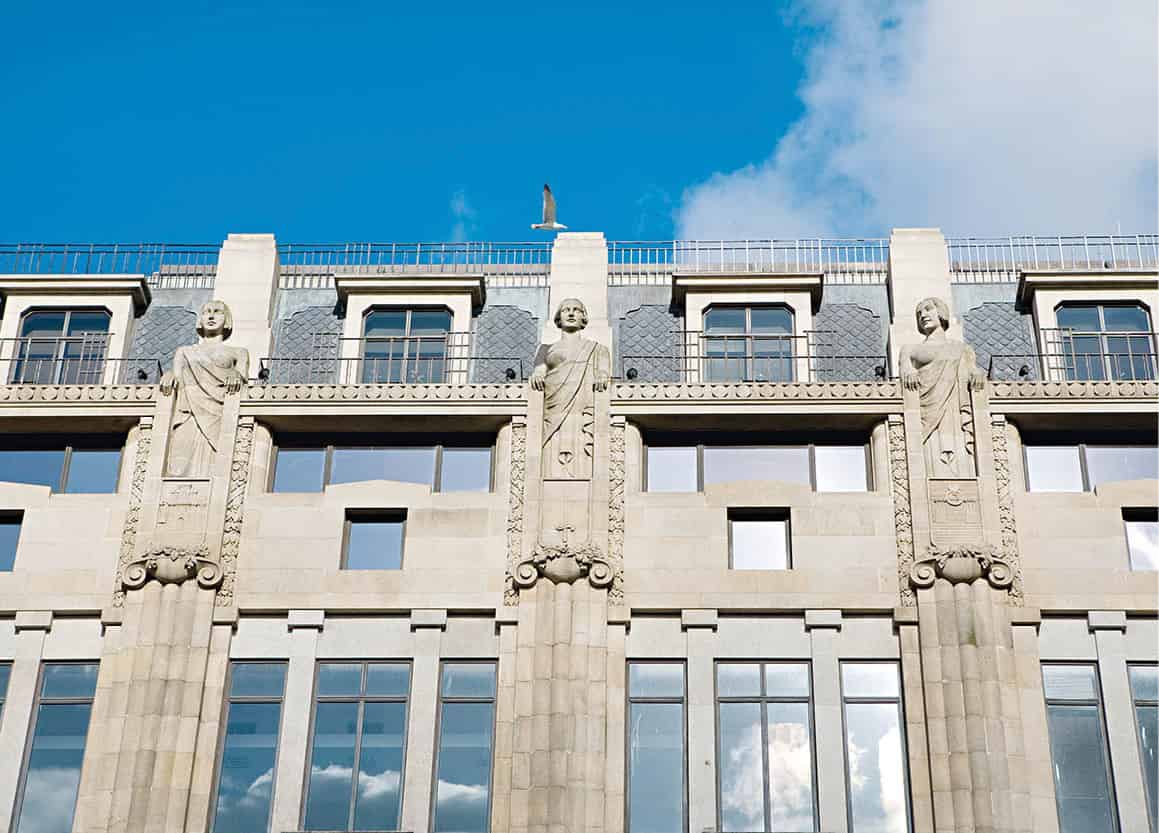
Praça da Liberdade is considered the centre of Porto.
Lydia Evans/Apa Publications
The old city
The heart of the city is the Praça da Liberdade A [map], with its central equestrian statue of Pedro IV. On the north side of the square is the broad Avenida dos Aliados, its bright flowerbeds covering part of the city’s Metro, opened in 2002. The avenue leads uphill to the Câmara Municipal B [map] (Town Hall) and the modern statue of Almeida Garrett (1799–1854), liberal poet and novelist, and native son of Porto.
To the southeast of Praça da Liberdade lies the Praça da Almeida Garrett, where the railway station, the Estação São Bento C [map], has a fine entrance hall decorated with traditional azulejos depicting historical scenes. From here you can catch a train for a journey along the Rio Douro to Pocinho.
Heading south, you arrive at the 12th-century Sé D [map] (Cathedral; www.diocese-porto.pt; daily Apr–June and Oct 9am–12.30pm, 2.30–7pm, July–Sept 9am–7pm, Nov–Mar 9am–12.30pm, 2.30–6pm; free). It was here that King João I married Philippa of Lancaster in 1387, the year after the Treaty of Windsor was signed with England. The Gothic cloister is decorated with fine tiles. Just below, in the Medieval Tower, is a tourist office offering tours of the city and river (tel: 351 223 393 472; www.visitporto.travel). There is a good choice to suit various time frames and budgets, particularly the river trips, which vary from a 50-minute cruise of the bridges for €12.50 to a two-day cruise, including sightseeing and meals, starting from €135.
Nearby, on Pena Ventosa, the site of an ancient citadel, is the impressive 18th-century Palácio do Bispo E [map] (Bishop’s Palace). Just beyond is the Casa Museu de Guerra Junqueiro F [map] (Tue–Sat 10am–5pm, Sun 10am–12.30pm and 2–5.30pm), in the house of the highly regarded poet of that name, who died in 1923. His memorabilia and furnishings are on display.
Across the avenue stands the 15th-century Igreja Santa Clara G [map] (Mon–Fri 9–noon, 3.30–6pm, Sat 3–6pm, Sun 10am–11am; free), next to one of the best-preserved sections of the old city wall. Santa Clara has been rebuilt several times but is noted for its splendid gilded wood choir stalls and altars. Sacheverell Sitwell wrote: “After it, every other building in Porto, even São Francisco, is drab and dull.”
To the west, the Igreja São Lourenço H [map] (Tue–Sat 10am–1pm, 2.30–5pm; free), better known as Igreja dos Grilos (after the crickets that lodge there), was built in 1570 and is one of the earliest examples of Portuguese Baroque.

Colourful laundry on the line.
Lydia Evans/Apa Publications
The western side
At the end of Rua Infante Dom Henrique stands the bastion of English life, the Feitoria Inglesa I [map] (English Factory House; free). Here, the old British port-wine shippers do their business, play billiards or cards, read English newspapers and enjoy English food, as they have for the past 200 years.
Around the corner, on Rua da Alfândega, stands the much-restored Casa do Infante J [map] (Tue–Sun 10am–1pm and 2–5.30pm; free on weekends), where Prince Henry the Navigator was born in 1394. For a time it served as the customs house; it is now a museum with three floors of exhibits relating the history of Porto’s trade and industry. Also on display are the Roman foundations and mosaics discovered during excavation.
Going by the Praça do Infante Dom Henrique, you reach the Igreja São Francisco K [map] (daily July–Sept 9am–8pm, Oct and Mar 9am–7pm, Nov–Feb 9am–5.30pm), founded by King Sancho II in 1233 and rebuilt in the 14th century. The interior glitters in Baroque splendour with gilded columns, arches and statues. On the site of a convent, which burnt down in 1832, is the Palácio da Bolsa L [map] (Stock Exchange; guided tours May–Sept 9am–7pm, Oct–Apr 9am–1pm, 2–6pm), noted for its opulent reception hall. Up the hill is the Instituto dos Vinhos do Douro e Porto M [map] (Port and Douro Wines Institute), the government agency established in 1932 to control the quality of port.
Following the Rua Belmonte past old homes with balconies and tiled walls, you arrive at the church of São João Novo N [map], built in 1592.
The road leads to the Centro Português de Fotografia O [map] (www.cpf.pt; Mon–Fri 10am–6pm, Sat–Sun 3–7pm; free), housed in a former prison and mainly showcasing the work of Scottish-born photographer Frederick William Flower (1815–89), who lived in Porto for most of his life.
Just beyond here is the singular 18th-century Torre dos Clérigos P [map] (torredosclerigos.pt; daily 9am–7pm), the tallest granite tower in Portugal. This was designed, along with its church, by Nicolau Nasoni, who was also architect of the fine Baroque Solar de Mateus near Vila Real. Unless you really have no head for heights it is worth climbing the 225 or so steps for the view over the city. Just north of the tower lies the main university building, a handsome granite structure built in 1807 as the Polytechnical Academy. Across the Praça do Lisboa on Rua das Carmelitas, the Lello & Irmão library and bookshop (www.livrarialello.pt) should not be missed. Dating from 1906, it has a winding wooden staircase, bright red steps and a striking stained-glass ceiling. Rumour has it this arresting interior was an inspiration to J. K. Rowling, who frequented the shop during her time living in Porto.
East of São Bento railway station lies the busy Praça da Batalha Q [map], with a statue of Pedro V in the middle, and the imposing 18th-century church of São Idelfonso with a facade of bright blue-and-white tiles. The main shopping street is Rua Santa Catarina, where bargains may be found in a variety of goods, from shoes to pottery. On the same street at no.112 is Café Majestic (www.cafemajestic.com), famous not only for its excellent coffee but also for its beautiful interior, decorated in marble and wood and decked out with impressive mirrors, cherubs and chandeliers. It is still visited by the local elite. Rua das Flores has the best gold and silver shops.
Cais da Ribeira
Take the steep roads down to the river, and you will find yourself drawn to the Cais da Ribeira R [map], one of the liveliest parts of the city and a Unesco World Heritage Site. Many small shops and restaurants are built right into what remains of the old city wall, some showing watermarks around 2 metres (6ft) from the floor where the river has burst its banks. During the day you can take a river trip from here, and in the evening its restaurants brim with customers.
Ten minutes’ walk downriver brings you to the electrico stop, a tram that goes out to Castelo de Queijo on the coast. Just beyond is an excellent Port Wine Museum (Tue–Sat 10am–5.30pm, Sun 10am–12.30pm, 2–5.30pm; free on weekends).
The splendid steel arch further upriver is a railway bridge, Ponte de Dona Maria Pia, built in 1876 to plans by Alexandre Gustave Eiffel and only recently put out of use by the new Ponte São João. In the centre of Porto is the handsome Ponte Dom Luís I S [map], built in 1886, which provides splendid views. This two-storey iron bridge has two decks, the upper of which will carry the new Metro line, and leads directly to port cellars in Vila Nova de Gaia (for more information, click here).
Fact
On the Festa de São João (23–24 June), festivities take place near the Ponte Dom Luís I. There is a regatta of the port-wine boats, and people sing, dance around bonfires and feast on roast kid and grilled sardines – and hit each other over the head with plastic hammers.
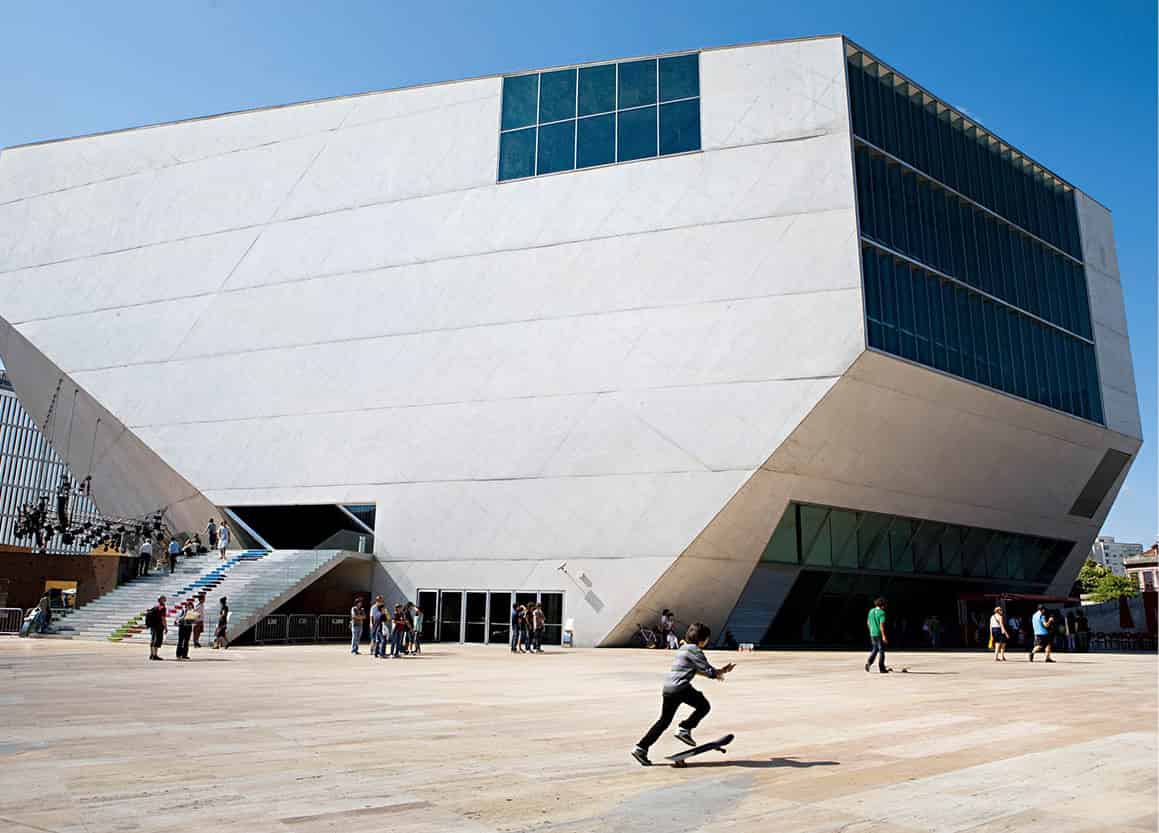
Casa da Música is the major concert space in Portugal.
Lydia Evans/Apa Publications
Outside the old town
On the western side of the city, in the old royal Palácio dos Carrancas, is the Museu Nacional Soares dos Reis T [map] (www.museusoaresdosreis.pt; Tue–Sun 10am–6pm; free on the first Sunday of every month), named after a 19th-century sculptor. It has a fine collection of archaeological artefacts, religious art, regional costumes, ceramics and contemporary paintings, as well as sculpture. Paintings by Grão Vasco are on display, among them pictures of St Catherine and St Lucy.
On the western side of the Jardim do Palácio de Cristal (entered from Rua Entre Quintas) is the intriguing Museu Romântico U [map] (Mon–Sat 10am–5.30pm, Sun 10am–12.30pm, 2–5.30pm; free on weekends), which recreates and evokes the life of the Portuguese 19th-century bourgeoisie. It’s located in the Quinta da Macieirinha, where King Carlo Alberto died in 1849, after abdicating the throne of Sardinia. The mansion is set in a rose garden and contains most of its original furnishings.
North of here, via Rua de Don Pedro V, is the splendid Casa da Música (www.casadamusica.com; Mon–Sat 9.30am–7pm, until 6pm on Sun; for guided tours call 220 120 120). Designed by top Dutch architect Rem Koolhaas, this ultra-modern geometric building has an extraordinary interior space. Regular concerts are staged here, ranging from fado to classical music, and the building may also be visited and appreciated for its innovative architecture and interior design.
To the northwest, in Boavista, is the Art Deco Museu Serralves (www.serralves.pt; Apr–Sept Tue–Fri 10am–7pm, Sat–Sun 10am–8pm, Oct–Mar Tue–Fri 10am–6pm, Sat–Sun 10am–7pm), set in an attractive 18-hectare (44-acre) estate. The mansion holds temporary exhibitions of modern art. In the grounds is the stunning Museu de Arte Contemporânea (hours as above), designed by Porto architect Alvaro Siza Vieira, which has both permanent and temporary exhibitions. As well as a large, light exhibition space, the building comprises an auditorium, a restaurant and a library.
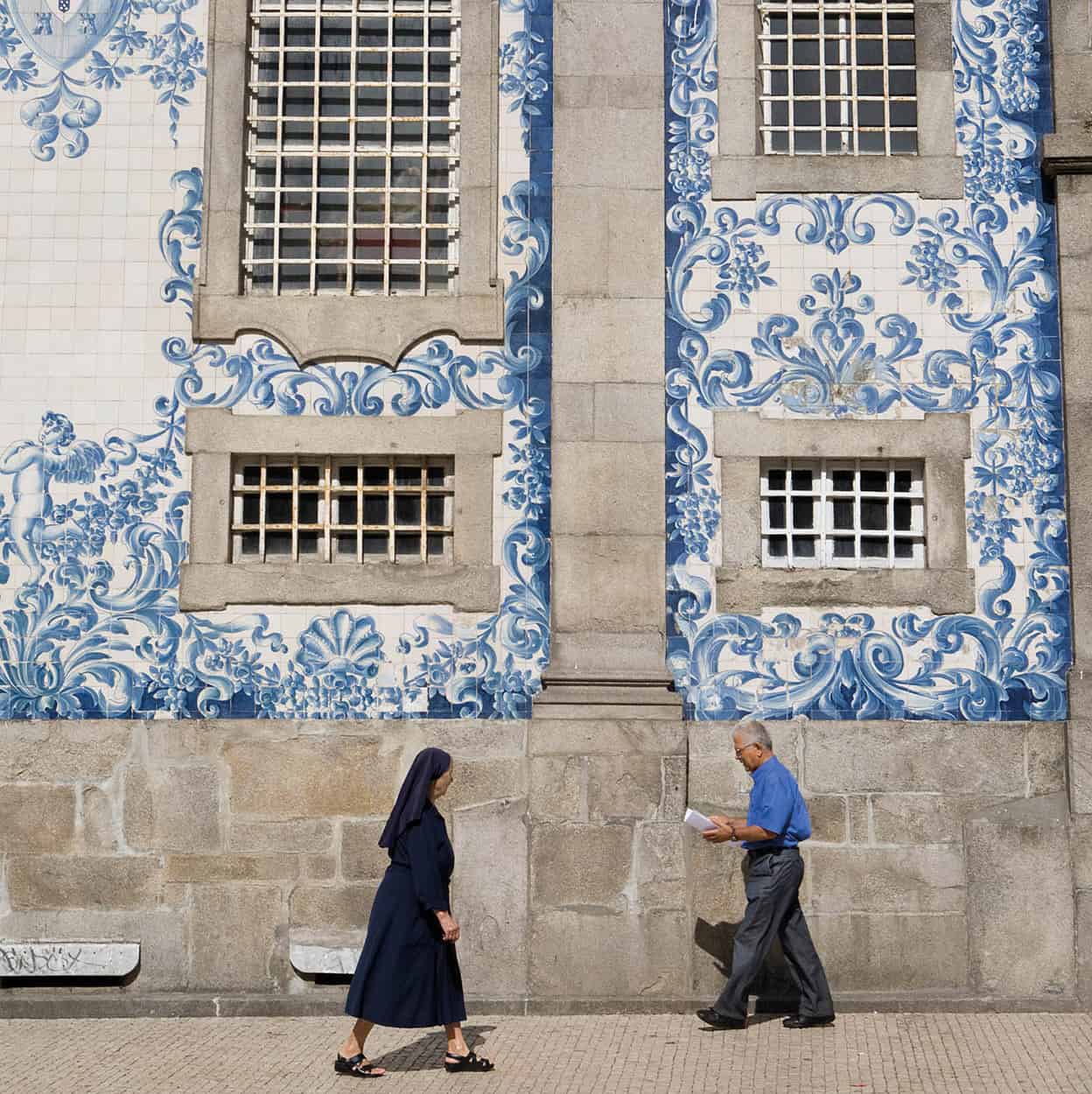
The azulejos-rich exterior of Igreja do Carmo, a Carmelite church.
Lydia Evans/Apa Publications
Porto is best known for being the home of port which has made something of a comeback in recent years, shedding its previous stuffy image as being primarily a gentleman’s after-dinner drink to be enjoyed, typically, with a fat cigar.
Vila Nova de Gaia, across the Ponte Dom Luís I, is an industrial zone with ceramic, glass, soap and other factories. But above all, Gaia is the true seat of the port-wine industry, where most warehouses or lodges are to be found. There are about 80 port-wine lodges here: many of the larger ones welcome weekday visitors to tour the installations and, better still, taste their wines (which most visitors will then purchase). Most prominent is Sandeman (www.sandeman.eu; daily 10am–12.30pm and 2–5.30pm), whose distinctive silhouette, designed in 1928, rises on the skyline. Another good choice is British-owned Taylor’s (http://taylor.pt; daily 10am–6pm). The port-wine lodges line the waterfront and fly their flags from barcos rabelos moored alongside.
In spring, the new wine is brought down from the Upper Douro by truck, and is then left to mature in 530-litre (140-gallon) oak casks, or pipes. Here the blending takes place, with wines from different vineyards and different years blended to produce a distinctive aroma, taste and colour before the wine is bottled and again left to mature.
In the evening, many people cross the bridge to eat and enjoy a great view of the city opposite. Apart from traditional restaurants, at the far end of the quay there is a wide choice of places to eat and drink in the modern riverside Cais de Gaia complex, with terraces and river views. For unrivalled panoramas of the city and the river, take the Gaia Cable Car (www.gaiacablecar.com; May–Sept 10am–8pm, Apr and Oct until 7pm, Nov–Mar until 6pm) which links Gaia riverside promenade with the Jardim do Morro (upper station). A single adult ticket currently costs €5 (€8 return).
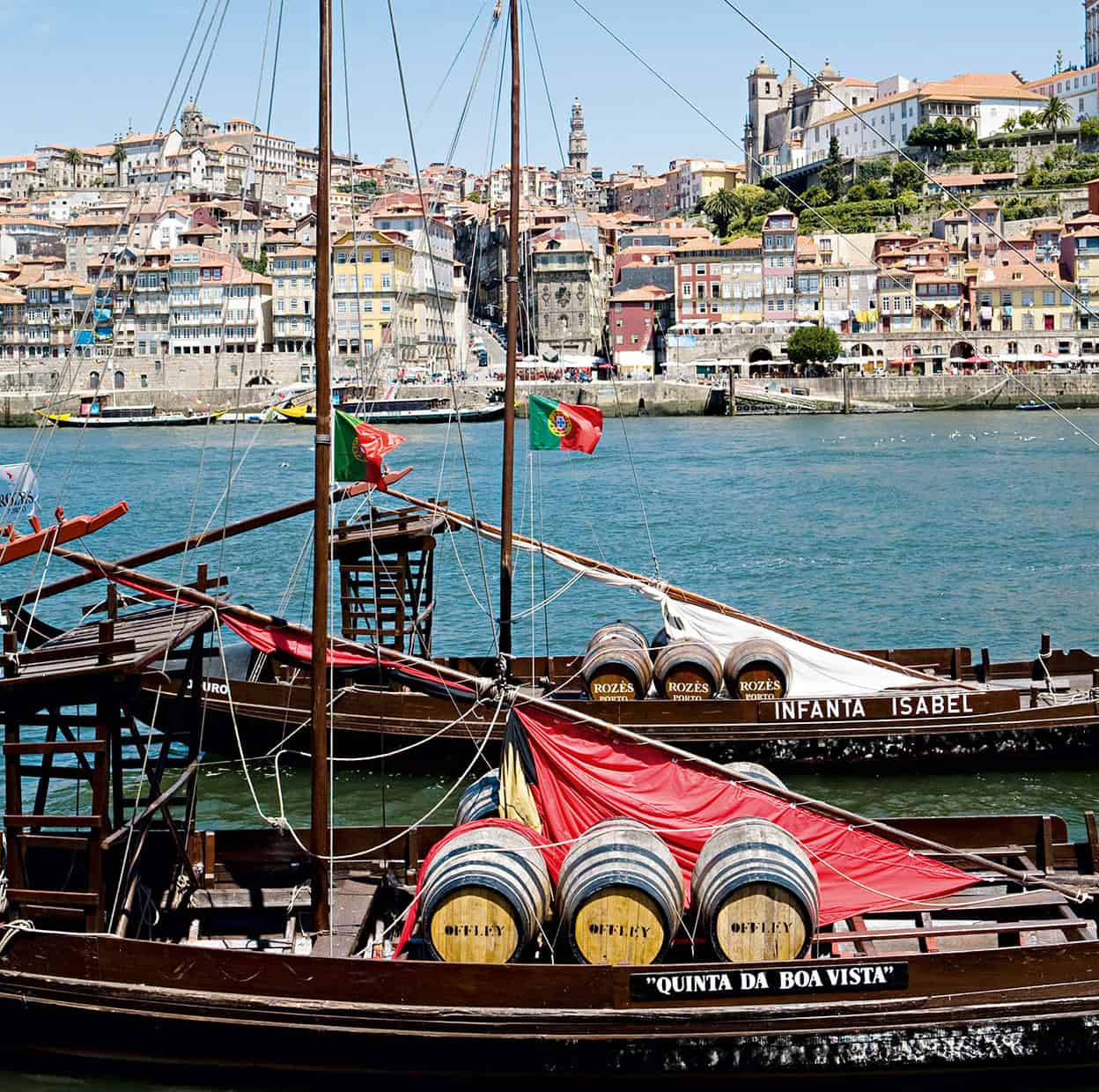
Boats along the Douro River.
Lydia Evans/Apa Publications
Barcos rabelos
The barcos rabelos have become a symbol of port wine, the product with whose destiny they have been entwined for hundreds of years.
On his return to Lisbon after discovering the sea route to India in 1498, Vasco da Gama proclaimed “Somos a gente do mar” (We are the people of the sea). Using small, light, high-prowed caravel sailing ships based on an ancient Mediterranean design, 15th- and 16th-century Portuguese explorers voyaged the world and Portugal became the greatest maritime nation on earth.
A generation later Portugal lost its superior position, but numerous seafaring traditions were still in place. And as Portugal retreated into centuries of introspection, the boat-building techniques and traditions left by ancient mariners were retained.
Best known are the flat-bottomed, square-rigged barcos rabelos, which are a familiar sight in Porto.
Viking similarities
In traditional barco rabelo building the hull’s shell is laid first, then the ribs are placed. This is the Nordic “clinker-building” method which may be a direct Viking legacy. A comparison between the bare hull of a rabelo and that of a reconstructed longboat in Oslo’s Viking Museum shows striking similarities. Other features of the rabelo’s design evolved in the 17th century, the nascent period of the trade in port wine. Ever since then the grapes for port have been grown in the upper reaches of the Douro valley, from where the wine is transported to Vila Nova de Gaia for shipment abroad. The adapted indigenous boats of the Douro were constructed in large numbers and put to this use on the treacherous river, stacked with casks of wine. Flat bottoms were needed to shoot the rapids, negotiate the shallows, and achieve high loading ratios. A tall platform at the stern gave the helmsman a clear view over the rows of casks, and a huge steering oar, or espadela – effectively a rudder – was needed to change course rapidly. This also had to be capable of being levered out of the water to avoid smashing in the rapids and rocky shallows. Intrepid boatmen slept and ate on board, suspending cauldrons from a beam and boiling their traditional dishes of bacalhau (dried cod).
The damming of the Douro for hydroelectric power brought an end to the rabelo’s interdependence with the port trade. But although port now makes the journey from the Upper Douro by road, the rabelo has proved an irrepressible symbol of the product. Boats are still constructed, at great expense, to compete in the annual race of rabelos owned by the port-shipping firms. The regatta, enthusiastically contested, is held on 24 June, the festival of São João (Porto’s patron saint), when the city erupts in revelry. Boats set off from the mouth of the Douro, with the race climaxing at the Dom Luís I bridge.
The set of rules ensuring that the rabelos are constructed precisely according to the specifications evolved during their heyday is taken very seriously. The craft have to be built in yards along the Douro, with the hull constructed from maritime pine, and laid down by the “clinker-building” technique. The largest rabelos are around 24-metres (80ft) long by 5.5-metres (18ft) wide with 80 sq metres (860 sq ft) of sail billowing in the wind, and need at least a dozen crew members. Payloads are up to 65 casks, each holding 522 litres (138 gallons) of port.
The regatta proves that the boats are more than advertisements for their owners’ wares.
